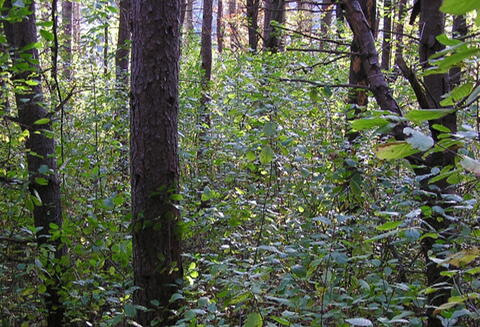Forest landowner motivation to control invasive species depends on land use, study shows

Many U.S. forests are privately owned, particularly in the Eastern and North Central part of the country. This makes control of invasive plants and pests challenging because efforts must be coordinated across landowners. A new study from the University of Illinois Urbana-Champaign explores how differences in ownership motivation affects willingness to control, and how economic incentives can be implemented most efficiently.
“Some own the land for recreational purposes, some own it because they want to produce timber, and some are a combination of both. If one landowner controls invasive species but their neighbor does not for some reason, that could be problematic because the bioinvasion will spread over space and time,” said study author Shadi Atallah, associate professor in the Department of Agricultural and Consumer Economics, part of the College of Agricultural, Consumer and Environmental Sciences at Illinois.
Currently, conservation cost-share programs reimburse forest landowners for up to 75% of the cost of controlling invasive species. However, this is not necessarily the most efficient use of funds, Atallah noted.
“When you're incentivizing someone to do something, you would like to know they weren't going to do it without the incentive, or you have wasted your money. Would it make sense to change who qualifies for these payments in a way that optimizes the effect?”
Atallah employed game theory to explore these questions, using the example of glossy buckthorn in U.S. Eastern white pine forests. Glossy buckthorn is a fast-growing shrub that is exotic and invasive in North America. It can form a dense, persistent layer in forest understories, interfering with the growth of young pine trees and affecting wildlife habitat.
In a previous study, Atallah surveyed Maine and New Hampshire family forest landowners to understand how their willingness to control glossy buckthorn was motivated by the shrub’s effects on timber, trail recreation, and wildlife viewing. For the current study, he developed a theoretical modeling framework that estimated how each type of landowner would act and how their neighbor would respond, given various circumstances over a period of time.
“The model focuses on two cases: one is the recreationist, who likes to hike and enjoy the land, but they don't like that the invasive shrub will block their path and interfere with wildlife viewing. The other is the timber producer, who gets a reduced amount of timber if the invasive shrub prevents white pine from growing to maturity,” he explained.

Atallah also considered the connectivity between forests and how the bioinvasion spreads to surrounding areas.
“Some invasive species are mostly spread by short distance dispersal, such as squirrels or other small mammals, while other species are spread through long-distance dispersal, such as birds and waterfowl, and the spread can be either fast or slow. Another factor is where the bioinvasion first appears and whether it makes sense to prioritize control at the starting point,” he said.
He found that in most scenarios, the recreationist would not control the invasive shrub without cost-share payment, while the timber owner would choose to control regardless of subsidies.
“Only in the case of fast long-distance dispersal does control get so expensive that nobody can do it without support. This is consistent with what we are currently doing; everybody qualifies for it. However, in all other cases – slow long-distance dispersal, and slow or fast short-distance dispersal – it would make sense to pay only the recreationists, who act as sources of bioinvasion spread when they refrain from control.”
Atallah noted that this may not seem fair; however, the timber landowners would still benefit even if only the recreationists are subsidized, because the spread is contained earlier and to a larger extent.
“We find the cost of control for the timber producers becomes lower once you have cleaned up the neighboring forestlands. Instead of partially reimbursing both types of landowners, the money could be used to cover 75% of control for the recreationist, and as a result, the timber owner would have less invasive species to deal with and control would be less expensive.”
The study provides one example of different landowner motivations, but this doesn’t mean the same dynamic always plays out, Atallah stated.
“My conclusion is that we should provide the subsidy to the weakest link, which is the entity that wouldn’t act otherwise and ends up acting as the source of the externality. In this case it’s the recreationist, but you could imagine a situation where it was the other way around. The model is adaptable to any given scenario,” he said.
“The idea is to consider any two different motivations to own the resource and how that could lead to different decisions in terms of controlling bioinvasion spread, and thinking about prioritizing those who would not control without subsidies.”
The paper, “Spatial Bioinvasion Externalities with Heterogeneous Landowner Preferences. A two-agent bioeconomic model,” is published in Land Economics [DOI: 10.3368/le.101.2.112024-0209].